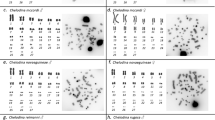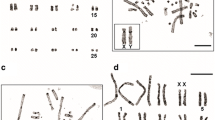Abstract
Reptiles display a wide diversity of sex-determining mechanisms ranging from temperature-dependent sex determination (TSD) to genotypic sex determination (GSD) with either male (XY) or female (ZW) heterogamety. Despite this astounding variability, the origin, structure, and evolution of sex chromosomes remain poorly understood. In turtles, TSD is purportedly ancestral while GSD arose multiple times independently. Here we test whether independent (XY or ZW) or morphologically divergent heterogametic sex chromosome systems evolved in tryonichids (Cryptodira) using the GSD spiny softshell turtle, Apalone spinifera, a species with previously unidentified sex chromosomes. A female-specific signal from comparative genomic hybridization (CGH) was detected in a Giemsa/4′,6-diamidino-2-phenylindole faint portion of a microchromosome, indicating the presence of a ZZ/ZW system in A. spinifera. In situ hybridization of a fluorescently labeled 18S rRNA probe identified a large nucleolar organizer region block in the female-specific region of the W (co-localizing with the female-specific CGH signal) and a smaller block on the Z. The heteromorphic ZZ/ZW micro-sex chromosome system detected here is identical to that found in another tryonichid, the Chinese softshell turtle Pelodiscus sinensis, from which A. spinifera diverged ∼95 million years ago. These results reveal a striking sex chromosome conservation in tryonichids, compared to the divergent sex chromosome morphology observed among younger XX/XY systems in pleurodiran turtles. Our findings highlight the need to understand the drivers behind sex chromosome lability and conservation in different lineages and contribute to our knowledge of sex chromosome evolution in reptiles and vertebrates.




Similar content being viewed by others
Abbreviations
- 2n:
-
Diploid number
- CGH:
-
Comparative genomic hybridization
- DAPI:
-
4′,6-diamidino-2-phenylindole
- FISH:
-
Fluorescent in situ hybridization
- gDNA:
-
Genomic DNA
- GSD:
-
Genotypic sex determination
- mya:
-
Million years ago
- my:
-
Million years
- NOR:
-
Nucleolar organizer region
- rRNA:
-
Ribosomal RNA
- TSD:
-
Temperature-dependent sex determination
- XX/XY:
-
Male heterogamety
- ZZ/ZW:
-
Female heterogamety
References
Abramyan J, Ezaz T, Graves JAM, Koopman P (2009) Z and W sex chromosomes in cane toad (Bufo marinus). Chromosome Res 17:1015–1024
Ayala FJ, Coluzzi M (2005) Chromosome speciation: humans, Drosophila, and mosquitoes. PNAS 102:6535–6542
Bachtrog D, Kirkpatrick M, Mank JE, McDaniel SF, Pires JC, Rice W et al (2011) Are all sex chromosomes created equal. Trends Genet: TIG 27:350–357
Bergero R, Charlesworth D (2009) The evolution of restricted recombination in sex chromosomes. Trends Ecol Evol 24:94–102
Bickham JW, Bull JJ, Legler JM (1983) Karyotypes and evolutionary relationships of trionychoid turtles. Cytologia 48:177–183
Born G, Bertollo L (2000) An XX/XY sex chromosome system in fish species Hoplias malabaricus, with a polymorphic NOR-bearing X chromosome. Chromosome Res 8:111–118
Bull JJ (1983) Evolution of sex determining mechanisms. Benjamin Cummings, Menlo Park
Bull JJ, Moon RG, Legler JM (1974) Male heterogamety in kinosternid turtles (genus Staurotypus). Cyto Cell Genet 13:419–425
Carr JL, Bickham JW (1981) Sex-chromosomes of the Asian black pond turtle, Siebenrockiella crassicollis (Testudines, Emydidae). Cyto Cell Genet 31:178–183
Charlesworth D, Charlesworth B, Marais G (2005) Steps in the evolution of heteromorphic sex chromosomes. Heredity 95:118–128
Ezaz T, O’Meally D, Quinn AE, Sarre SD, Georges A, Graves JAM (2008) A simple non-invasive protocol to establish primary cell lines from tail and toe explants for cytogenetic studies in Australian dragon lizards (Squamata: Agamidae). Cytotechnology 58:135–139
Ezaz T, Quinn AE, Miura I, Sarre SD, Georges A, Graves JAM (2005) The dragon lizard Pogona vitticeps has ZZ/ZW micro-sex chromosomes. Chromosome Res 13:763–776
Ezaz T, Valenzuela N, Grutzner F, Miura I, Georges A, Burke RL et al (2006) An XX/XY sex microchromosome system in a freshwater turtle, Chelodina longicollis (Testudines: Chelidae) with genetic sex determination. Chromosome Res 14:139–150
Ezaz T, Quinn AE, Georges A, Sarre SD, O’Meally D, Graves JAM (2009) Molecular marker suggests rapid changes of sex-determining mechanisms in Australian dragon lizards. Chromosome Res 17:91–98
Ezaz T, Sarre SD, O’Meally D, Graves JAM, Georges A (2010) Sex chromosome evolution in lizards: independent origins and rapid transitions. Cytogenet Genome Res 127:249–260
Goodpasture C, Bloom SE (1975) Visualization of nucleolar organizer regions in mammalian chromosomes using silver staining. Chromosoma 53:37–50
Graves J (2004) The degenerate Y chromosome—can conversion save it. Reprod Fert Develop 16:527–534
Graves JAM (2006) Sex chromosome specialization and degeneration in mammals. Cell 124:901–914
Green DM (1988) Cytogenetics of the New Zealand frog Leiopelma hochstetteri; extraordinary supernumerary chromosome variation and a unique sex-chromosome system. Chromosoma 97:55–70
Greenbaum E, Carr JL (2001) Sexual differentiation in the spiny softshell turtle (Apalone spinifera), a species with genetic sex determination. J Exp Zool 290:190–200
Iverson JB, Brown RM, Akre TS, Near TJ, Le M, Thomson RC et al (2007) In search of the tree of life for turtles. Chelon Res Monogr 4:85–105
Janzen FJ, Krenz JG (2004) Phylogenetics: which was first, TSD or GSD. In: Valenzuela N, Lance VA (eds) Temperature dependent sex determination in vertebrates. Smithsonian Books, Washington, pp 121–130
Kawai A, Nishida-Umehara C, Ishijima J, Tsuda Y, Ota H, Matsuda Y (2007) Different origins of bird and reptile sex chromosomes inferred from comparative mapping of chicken Z-linked genes. Cytogenet Genome Res 117:92–102
Kirkpatrick M, Barton N (2006) Chromosome inversions, local adaptation and speciation. Genetics 173:419–434
Kleinjan D, van Heyningen V (1998) Position effect in human genetic disease. Human Mol Genet 7:1611–1618
Lepesant J, Cosseau C, Boissier J, Freitag M, Portela J, Climent D et al (2012) Chromatin structural changes around satellite repeats on the female sex chromosome in Schistosoma mansoni and their possible role in sex chromosome emergence. Genome Biol 13:R14
Martinez P, Valenzuela N, Georges A, Graves JAM (2008) An XX/XY heteromorphic sex chromosome system in the Australian chelid turtle Emydura macquarii, a new piece in the puzzle of sex chromosome evolution in turtles. Chromosome Res 16:815–825
McBee K, Bickham JW, Rhodin AGJ, Mittermeier RA (1985) Karyotypic variation in the genus Platemys (Testudines, Pleurodira). Copeia 1985:445–449
Moran P, Martinez JL, Garcia-Vazquez S, Pendas AM (1996) Sex linkage of 5S rDNA in rainbow trout (Oncorhynchus mykiss). Cytogenet Cell Genet 75:145–150
Nakamura M (2009) Sex determination in amphibians. Semin Cell Dev Biol 20:271–282
Organ CL, Janes DE (2008) Evolution of sex chromosomes in Sauropsida. Integr Com Biol 48:512–519
Otto SP, Pannell JR, Peichel CL, Ashman T-L, Charlesworth D, Chippindale AK et al (2011) About PAR: the distinct evolutionary dynamics of the pseudoautosomal region. Trends Genet 27:358–367
Pigozzi MI, Solari AJ (1999) The ZW pairs of two paleognath birds from two orders show transitional stages of sex chromosome differentiation. Chromosome Res 7:541–551
Reed K, Phillips R (1997) Polymorphism of the nucleolus organizer region (NOR) on the putative sex chromosomes of Arctic char (Salvelinus alpinus) is not sex-related. Chromosome Res 5:221–227
Schempp W, Toder R, Rietschel W, Gruetzner F, Mayerova A, Gauckler A (1993) Inverted and satellited Y chromosome in the orangutan (Pongo pygmaeus). Chromosome Res 1:69–75
Scherer G, Schmid M (2001) Genes and mechanisms in vertebrate sex determination. In: Scherer G, Schmid M (eds) Birkhäuser Verlag, Basel, p. 205
Schmid M, Haaf T, Geile B, Sims S (1983) Chromosome banding in Amphibia. VIII. An unusual XY/XX-sex chromosome system in Gastrotheca riobambae (Anura, Hylidae). Chromosoma 88:69–82
Schmid M, Ohta S, Steinlein C, Guttenbach M (1993) Chromosome banding in Amphibia. XIX. Primitive ZW/ZZ sex chromosomes in Buergeria buergeri (Anura, Rhacophoridae). Cytogenet Cell Genet 62:238–246
Seabright M (1971) Rapid banding technique for human chromosomes. Lancet 2:971–972
Sharma GP, Kaur P, Nakhasi U (1975) Female heterogamety in the Indian cryptodiran chelonian, Kachuga smithi Gray. In: Tiwari KK, Srivistava CB (eds) Dr. B.S. Chuahah Commemoration Volume. Zoological Society of India: Orissa, India, pp. 359–368
Solari AJ (1994) Sex chromosomes and sex determination in vertebrates. CRC Press, Boca Raton
Stock AD (1972) Karyological relationships in turtles (Reptilia: Chelonia). Can J Genet Cytol 14:859–868
Sumner A (1972) A simple technique for demonstrating centromeric heterochromatin. Exp Cell Res 75:304–306
Supanuam P, Tanomtong A, Khunsook S, Sangpakdee W, Pinthong K, Sanoamuang LO et al (2012) Localization of nucleolar organizer regions (NORs) of 4 gibbon species in Thailand by Ag-NOR banding technique. Cytologia 77:141–306
Takehana Y, Naruse K, Asada Y, Matsuda Y, Shin-I T, Kohara Y et al (2012) Molecular cloning and characterization of the repetitive DNA sequences that comprise the constitutive heterochromatin of the W chromosomes of medaka fishes. Chromosome Res 20:71–81
Valenzuela N (2004) Evolution and maintenance of temperature-dependent sex determination. In: Valenzuela N, Lance VA (eds) Temperature dependent sex determination in vertebrates. Smithsonian Books, Washington, pp 131–147
Valenzuela N (2010) Co-evolution of genomic structure and selective forces underlying sexual development and reproduction. Cytogenet Genome Res 27:232–241
Valenzuela N, Adams DC (2011) Chromosome number and sex determination co-evolve in turtles. Evolution 65:1808–1813
Valenzuela N, Adams DC, Janzen FJ (2003) Pattern does not equal process: exactly when is sex environmentally determined? Am Nat 161:676–683
Valenzuela N, Lance VA (eds) (2004) Temperature dependent sex determination in vertebrates. Smithsonian Books, Washington
Vogt RC, Bull JJ (1982) Temperature controlled sex-determination in turtles—ecological and behavioral aspects. Herpetologica 38:156–164
Wiley J (2003) Replication banding and FISH analysis reveal the origin of the Hyla femoralis karotype and the XY/XX sex chromosomes. Cytogenet Genome Res 101:80–83
Acknowledgments
We thank Jim Millard for providing the A. spinifera samples. Hawaiian P. sinensis samples were collected under Hawaii DLNR Department of Aquatic Resources Special Activities Permit 2011-061 with funding from the CSU Chico Center for Water and the Environment to T. Engstrom. This work was partially funded by NSF grant MCB 0815354 and supplements to N. Valenzuela and S.E. Edwards.
Author information
Authors and Affiliations
Corresponding author
Additional information
Responsible Editor: Fengtang Yang.
Rights and permissions
About this article
Cite this article
Badenhorst, D., Stanyon, R., Engstrom, T. et al. A ZZ/ZW microchromosome system in the spiny softshell turtle, Apalone spinifera, reveals an intriguing sex chromosome conservation in Trionychidae. Chromosome Res 21, 137–147 (2013). https://doi.org/10.1007/s10577-013-9343-2
Received:
Revised:
Accepted:
Published:
Issue Date:
DOI: https://doi.org/10.1007/s10577-013-9343-2




